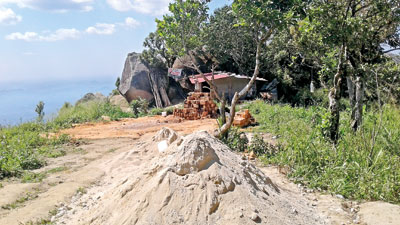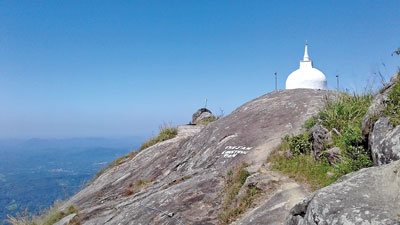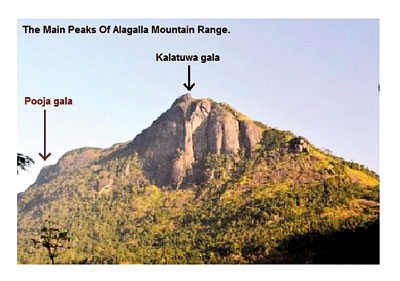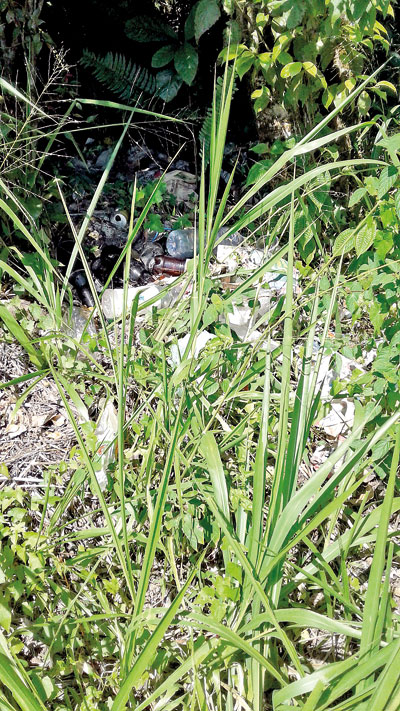News
Alagalla: Has the rape of forest reserve begun?
- A chance sighting of an illegal structure in-the-making raises questions
- The Naranbedda Forest Office–the relevant area authority lacks resources to do regular patrols
- The only building that has got authorisation is the existing temple, say officials
Environmentalists on a research expedition two weeks ago stumbled upon building materials and the signs of a “house” being erected on the mountain range within the picturesque Alagalla Forest Reserve in the Kegalle District.
There was evidence of sand and soil quarrying. Plastic bottles and polythene material were strewn around. The group was immediately suspicious that the permanent structure they saw before them was taking shape as a tourist rest.

Signs of building activities
Since December 2012, vast swathes of Alagalla, including where the researchers now stood, have been “reserved forest” under the Forest Conservation Ordinance. Also known as the Potato Mountain range and bordering the Central and Sabaragamuwa Provinces, the reserve is a watershed for many rivers including the Maha Oya and Rambukkan Oya.
A number of small springs vital to households and to paddy cultivation are found at the base of the range. Isolated hill forests like Alagalla are vital to conserving biodiversity as some of the country’s endemic species are restricted to these patches, environmentalists said, adding that they assist in the migration of faunal species between much larger forest reserves through geographical linkage.

The gleaming white chaithya--was erected on the Pooja Gala section of the mountain range in 2014
This isn’t the first time Alagalla’s status as a protected forest has been violated. In May 2014, the Alagalla Pabbatharamaya–a gleaming white chaithya–was erected on the Pooja Gala section of the mountain range. It was inaugurated in November the following year.
The Conservator General of Forests, whose job it is to oversee these matters, had approved the temple construction on a request by the Secretary of the Kehelwatte Wattegama Dhammika Sri Punyawardanaramaye Dayaka Sabhawa, said officials from the Rambukkana Divisional Secretariat and the Kegalle Divisional Forest Office.
The “miscellaneous permit” said an area of 0.0777 hectares or three-fourth of an acre could be used. And it imposed terms and conditions, including the payment of a mere Rs 200 annual rent and yearly renewal of the licence. It also prohibited the transfer of land access to third parties without the permission of the Forest Conservator.

The Main Peaks Of Alagalla Mountain Range
The new “house” the researchers found is around 100m from this temple. And the workers camping there had claimed they received approval for it from the chief priest of the chaithya, Ven Kadigamuwe Dhammika Thera. He did not answer his phone despite repeated attempts to contact him.
Among other things, regulations imposed under the Forest Conservation Ordinance strictly prohibit the clearing or breaking up of soil, digging up of any land for cultivation, preparing of land for any building purposes or cultivating of any land already cleared within a reserve. It is also banned to erect any hut or building (permanent or temporary) or to occupy any building so erected.

Plastic bottles and polythene material were strewn around
In addition to imprisonment or fines, the punishment for offences comprises compensation for any damage caused to the reserved forest. “Such compensation shall be equivalent to the actual value of the damage caused to the Reserved Forest and shall be charged and recovered as a fine levied by Court,” the law states.
Construction of any kind was strictly prohibited in a forest reserve, confirmed Jagath Gunawardena, environmental lawyer. Nevertheless, the Act provides for religious institutions to establish “hermitages” in specified areas with official permission from the Forest Department of Sri Lanka.
And, yet, the Alagalla Pabbatharamaya is not registered under the Vihara Gam Dewala Act (Buddhist Temporalities Ordinance), which is implemented by the Ministry of Buddha Sasana. It is only approved by the Department of Forests.
But it was not uncommon for temples to be unregistered because of rivalries among chief priests, an official from the Vihara Gam Dewala Division of the Ministry of Buddha Sasasana said. They often block new places of worship from being registered in order to prevent them from eating into their reservoir of devotees.
Temples such as these are usually erected only in places of religious significance due to the sensitivity of the ecosystems in reserved forests. He was not aware of the site having such importance, said G S D Gamlath, Assistant Divisional Secretary of Rambukkana. He said he would inquire from the local population.
In recent times, the Alagalla Pabbatharamaya has become a popular tourist destination for those who favour the mountain range for its environmentally diverse hiking trails and scenic water bodies, such as the Dekinda Ella. There are now more people going into the reserve, impacting its balance, an environmentalist said, requesting anonymity over personal safety concerns.
The Naranbedda Forest Office–the relevant area authority–did not know about the new building activity until the Sunday Times questioned them about it. If they patrolled the reserve at all, it would rarely be more than once a year. They had only two officers and were severely handicapped by a lack of resources and funds.
“They have to patrol from Rambukkana to Mawanella, which is around 100km, with only Rs 3,000 worth of diesel given per month,” said an authoritative source. “There are only two of them and they spend their time attending office work, going to courts and patrolling as many forests and possible.”
Conservator General W A C Weragoda confirmed that his Department faced severe challenges owing to a shortage of field workers such as beat officers.
Additionally, the legislation related to reserved forests was technical. Local residents often lacked the information they needed to be vigilant to potential violations of conditions in the miscellaneous permit. This, paired with no field monitoring, has resulted in more structures coming–including in areas around the temple. The floodgates, environmentalists fear, are being thrown open to further rape of the forest.
There has been no authorisation for any other construction but the chaithya by the Rambukkana Divisional Secretariat, the Kegalle Divisional Forest Office and the Rambukkana Forest Office. The structures the environmentalists came upon, therefore, were illegal.
On Monday, people will start trekking up to the chaithya for an annual pilgrimage. The Naranbedda Forest Office is expected to go up there to tell them not to litter. Large crowds converging on the reserve is bad enough. Now it remains to be seen what they will do about the increasing modifications that are taking place around the temple, seemingly unbeknownst to the very authorities tasked with preventing them.

